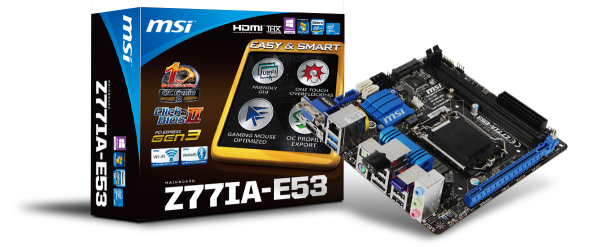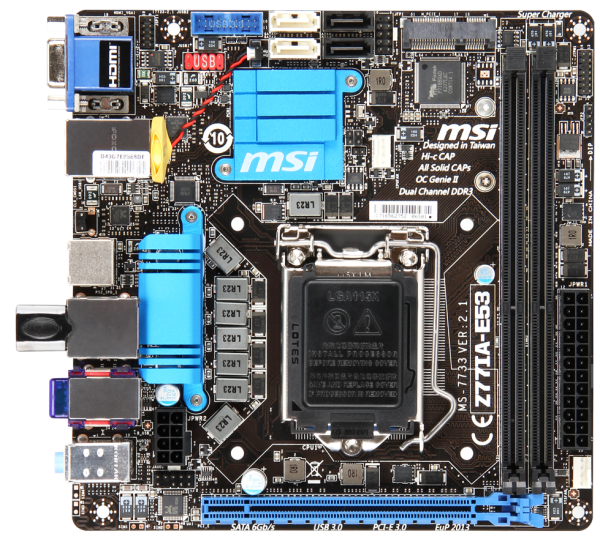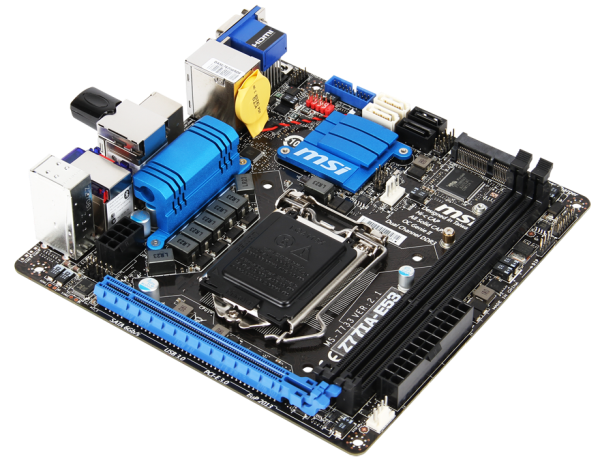Z77 mITX Round-Up: Five of the Best – MSI, Zotac, ASRock, EVGA and ASUS
by Ian Cutress on December 31, 2012 7:00 AM EST- Posted in
- Motherboards
- MSI
- ASRock
- EVGA
- ZOTAC
- Asus
- Ivy Bridge
- Z77
- mITX
MSI Z77IA-E53 Overview
The MSI Z77IA-E53 retails for $145, the cheapest of the roundup, below the $160 for the Zotac and $150 for the ASRock. For the money, we get a motherboard oriented such that the chipset is above the socket, an odd location for the CPU Power connector, and a novel combination of features on board. We have access to the Realtek ALC892 audio codec and Realtek 8111E GbE NIC, a single HDMI video connection, a single VGA connection, no on/off buttons or debug LED, but an included WiFi module. There are no extra SATA or USB controllers, with MSI deciding to forgo these additional features for the sake of a PS/2 combination port and a ClearCMOS button on the rear IO.
In terms of design, the orientation of the features gives rise for concern – especially the placement of the CPU power connector. As it is near the rear IO at the bottom of the board just above the PCIe slot, it stands to reason that some home builds of this machine will require a PSU cable to reach over most of the motherboard or the GPU – not an ideal solution. One design choice I do agree with however is the placement of the onboard battery – rather than using PCB space in a flat configuration, or placement issues in an upright position, we have it stuck to the rear IO. As long as the adhesive holds there should be no issues. Ideally I guess it be better if it was fixed into the chipset heatsink.
Despite the size of mITX, MSI have gone with full length DDR3 instead of SO-DIMM, and these slots also exhibit a single sided latch system for easy placement and removal. The socket location is right up against the memory and PCIe slot, meaning that CPU coolers have to conform to Intel’s x-y dimension specifications and any GPU with a back plate may have issues depending on the cooler used.
Performance wise, the only snag with the MSI board (as with any 7-series MSI board we have tested recently) is the USB 2.0 speed. Despite this being part of the chipset, the peak speeds we achieve are only ~25 MBps read and write, rather than the 32+ we see on any other motherboard. It also seemed odd that our POST times when running a stripped setup in the BIOS were actually 33% longer than normal POST – 12.68 seconds for a ‘stripped’ POST against 9.63 seconds for a default POST with a single GPU installed.
I still maintain that MSI have some design wins in the BIOS, especially by giving the information regarding the setup on the front screen and this information being continually present throughout what option in the BIOS you choose. The BIOS options themselves could be laid out better, and the idea of a graphical and interactive interface has only been half-attempted. In terms of software, MSI keeps a user up-to-date with their Live Update system which checks the servers for updates. This can be useful if there is a minor patch needed to be pushed through for better performance, or an irritant if a user wants to just plug and play. I rather like it when I can get it to work – I had to use the latest version of Live Update 5 from the website rather than the one on the install disk to get it to play ball.
All-in-all, the MSI board in terms of features and performance offers nothing above the grade, and if anything the USB 2.0 speed is a constant malady that needs sorting out. The BIOS and software design though are in the top tier if you want a deep interaction with your product.
Visual Inspection
In the year 2012, we have seen a variety of motherboard designs to titillate almost all the colors of the rainbow – yellow, orange, green, gold, red and blue for the most part. (I am still waiting on the pink, the white and the grey.) Normally a specific color scheme is for a product range, such as ROG, G1 or Fatal1ty. In the case of MSI, the normal scheme is the MSI logo blue combined with black. To do such a scheme on a mITX board should be easy – a mITX board is a niche product after all with a lot of potential. The downside comes when allocating colors for SATA connections, or trying to hide controllers and routing along with all the advertising and writing on board. For example, if a company has bulk-purchased their plastic connections 12-18 months ago, and are at a stage in their stock pile that only two colors are left., rather than the expense of buying more, they reuse the older ones until the stock is gone. Exceptions are made, such as the ROG and G1 lines of the other companies that are building brand names. As a result on the MSI Z77IA-E53, we get an attempt at black and blue, but the presence of white/black SATA ports, a red USB header, and the silver from all the solder points detracts from the aesthetics.
Like many of the other Z77 mITX boards on the market, MSI have decided to place the socket below the center of the board. This, as mentioned previously, has a couple of serious implications on the design. Firstly, the socket is at the minimum specified distance away from both the PCIe slot and the memory slots, meaning that all CPU coolers must conform to the Intel specification in the x and y directions. This limits large air coolers, and large GPUs with back plates may have trouble fitting in. The second issue comes from the presence of the power delivery – having the socket in this area means that the 12V CPU Power Connector is in an awkward position. In the case of the MSI Z77IA-E53, it is to the bottom left of the socket, and as such, any attempt to plug the connector in will need the cable to either stretch over the board, or stretch over a GPU. Neither is ideal when trying to produce a clean system build. A final issue is the location of the IO – as the chipset is near the top of the board, so are all the connections for USB and SATA ports. Due to the limited space to place components and features, the inclusion of a mini-PCIe/mSATA comes at the loss of a USB 2.0 header and two SATA 3 Gbps ports. This is up to the manufacturer, but at least MSI moves the on-board battery out of the way with some adhesive and places it on the rear IO.
Back into the board itself, we have two fan headers to use – one CPU 4-pin just above the socket, and a SYS 4-pin below the 24-pin ATX power connector. The power delivery uses a small bulky heatsink that hugs the IO panel, and we find the 8-pin CPU power connector just below this. The chipset heatsink by comparison is very small and flat, but should still be designed to dissipate the 7-8W that the chipset can produce. From the top left we get a red USB 2.0 header, a blue USB 3.0 header, the connection and wires for the on-board battery, two SATA 6 Gbps in white, two SATA 3 Gbps in black, the 4-pin CPU fan header to the right of the chipset, and an mSATA/mini-PCIe connection next to the memory slots. This mSATA/mini-PCIe will take any standard device for those two protocols, with the option to switch between the two found in the BIOS. The Fintek F71889AD chip underneath the spot where a mPCIe device would be is a SuperIO chip designed to add in the PS/2 functionality as well as hardware monitoring. Also to the right of the memory slots is a TPM header. This space between the memory and the edge of the board would be perfect to put power/reset switches or a debug LED (like on the Zotac mITX), but unfortunately all we get are components.
The rear IO is a little bleak due to the large gap in the middle. Other mITX boards we have reviewed have tried to do something a little different on the rear IO, such as dual HDMI + VGA, but here MSI have decided to remain a little basic. From left to right we have a VGA, HDMI, a Realtek 8111E GbE NIC, two USB 3.0 ports, a ClearCMOS button, optical S/PDIF output, a combination PS/2 port, a WiFi connection, four USB 2.0 ports, an eSATA port, a Bluetooth 3.0+HS module and a trio of audio jacks.
Board Features
| MSI Z77IA-E53 | |
| Price | Link |
| Size | Mini ITX |
| CPU Interface | LGA-1155 |
| Chipset | Intel Z77 |
| Memory Slots |
Two DDR3 DIMM slots supporting up to 16 GB Up to Dual Channel, 1066-2800 MHz |
| Video Outputs |
HDMI VGA |
| Onboard LAN |
Realtek 8111E WiFi 802.11 b/g/n |
| Onboard Audio | Realtek ALC892 |
| Expansion Slots |
1 x PCIe 3.0 x16 1 x mSATA/mini-PCIe |
| Onboard SATA/RAID |
2 x SATA 6 Gbps (Chipset) RAID 0, 1, 5, 10 2 x SATA 3 Gbps (Chipset) RAID 0, 1, 5, 10 |
| USB |
4 x USB 3.0 (Chipset) [2 back panel, 2 onboard] 6 x USB 2.0 (Chipset) [4 back panel, 2 onboard] |
| Onboard |
2 x SATA 6 Gbps 2 x SATA 3 Gbps 1 x USB 3.0 Header 1 x USB 2.0 Header 1 x TPM Connector 1 x Front Panel Audio 2 x Fan Headers 1 x Mini PCIe/mSATA |
| Power Connectors |
1 x 24-pin ATX Power Connector 1 x 8-pin CPU Power Connector |
| Fan Headers |
1 x CPU (4-pin) 1 x SYS (4-pin) |
| IO Panel |
1 x PS/2 Combination Port 4 x USB 2.0 2 x USB 3.0 1 x Realtek 8111E GbE NIC 1 x HDMI 1 x VGA 1 x Clear-CMOS Button 1 x Wi-Fi Antenna Connector 1 x eSATA 1 x Optical S/PDIF Output 3 x Audio Jacks |
| Warranty Period | 3 Years |
| Product Page | Link |
As mentioned in the visual inspection above, there are no real extras in terms of the MSI board – we arguably get the minimum we expect from a mITX product at this price range. There is perhaps scope to bump up the audio/Ethernet controllers to ALC898/8111F, or organise the layout to include more SATA ports onboard.














54 Comments
View All Comments
Sabresiberian - Tuesday, January 1, 2013 - link
Thanks for the great comparison review!It looks like there is a little mistake in the spec list for the Asus board, which shows it having a mini-PCIe connector. I would love it if it did, but I didn't see it on the board and it isn't mentioned in other spec lists.
It is important to me because I would ideally need connection for both a graphics card and a sound card (which I believe I could do through a mini-PCIe to PCIe x1 adapter if needed). This makes the EVGA Stinger the choice for me here, though the Asus board is the one I would prefer to buy.
I am truthfully a little disappointed in the EVGA board, which seems all too common with EVGA products in general these days. Great support is still there, but I'd rather they build bleeding edge components and not have to find out whether or not their support is as good as people say it is. The Stinger is a good board to be sure, and the Intel LAN alone puts it in the category of "will buy" for me, but I was hoping it would be something that would match or beat the Asus P877-I, and it just doesn't.
Foeketijn - Tuesday, January 1, 2013 - link
When you take overclocking out of the equation, B75 has it all, for the price just a tiny bit north of the old H61 chipset. Support for IB features (1600Mhz DDR3, PCI-e 3.0), Native Sata III, USB 3.0.It wasn't intended for the DIY market but fits the bill perfectly in my opinion. Only the very very few who need to OC, +16Gb ram or multiple SSD's @ full 6 Gb/s need the Z77 chipset.
The only thing is, that us mere mortals can't predict is, if a much cheaper chipset is used, did the OEM also cheapskate on the critical parts to? I would love to see some in-depth component analysis which I see for example, when a PSU is taken apart.
Which components are used? how well is the soldering done, does it still work at a sauna lanparty, etc.
I might be alone in this, but I would find that much more valuable information than all the performance benchmarks together (race to the bottom, be dammed!).
Including the northbridge in the CPU made motherboard and CPU reviews so predictible (or borring).Since then, I'm only interested in stability, ease of installation (nicely covered) and practical use (fan controll, MEM compatibility ect).
<offtopic> Oh I loved the XP-m 2500+ siverpainting 2001 era where you actually could get a noticeable improvement of performance and not necessarily have to sacrifice stability or risk bankruptcy</offtopic>
vanwazltoff - Tuesday, January 1, 2013 - link
i picked up an asus p8z77-i deluxe/wd before christmas and made a beast gaming computer out of it with an i5-3750k OCed to 4.5ghz and a gtx670 =]vanwazltoff - Tuesday, January 1, 2013 - link
*3570kBeaver M. - Tuesday, January 1, 2013 - link
Loved the POST screen measurements and the DPC latency testing. Something you dont see every day. Actually Ive never seen it, and yet I always wanted to know those.However I am not really interested in the Z77s, since they have a horrible layout for my needs. Only the Asus one comes close to what I need, but I just dont buy Asus anymore because of several very bas experiences.
So, I wish you would also test the B75 and H77s.
paksoy - Tuesday, January 1, 2013 - link
I love the features of this Asus mobo, but i want to use it in a really small form factor case like the Antec ISK 110 VESA Case.http://www.anandtech.com/show/6192/antec-isk-110-v...
I'm just worried that the height of the VRAM board would prevent it from using it with this case.
mi1stormilst - Tuesday, January 1, 2013 - link
I still opted for the Gigabyte Z77N and love it...Sivar - Wednesday, January 2, 2013 - link
Does this refer to the ALC889 playing an audio file encoded at 192KHz?If so, does it really matter? Failing a test is never a good thing, but I know of no widely available 192KHz audio source, and such a source would have no benefit, nor would a 96KHz source.
cjs150 - Wednesday, January 2, 2013 - link
I am a happy user of the AS Rock board in a silent HTPC. It works exceptionally well. However it is clear that some work still needs to be done on motherboard design.MSata on back is excellent - now can we have it as SATA 3 because the better MSata SSDs are all Sata 3.
Placement of Sata connectors is often awkward on these boards. On edge and at right angles please.
Similarly I would love it if someone either did the 24 pin ATX power connector at right angles or someone manufactured a right angled converter that did not require de soldering the motherboard connector. Cable management in Mini-OTX is very hard and that would really help.
Finally, careful choice of RAM can eliminate issues Ian had about the closeness of the CPU socket preventing the use of many after market coolers. I use the Samsung green low profie memory, which is so low that any after market cooler can be used (and runs at 1.35v, is an unbelievably good overclocker and reasonably priced!)
romrunning - Wednesday, January 2, 2013 - link
As has been mentioned previously, the H77 chipset is great for those who do not need overclocking. I've used the Intel DH77DF, and I heartily recommend it. Since the DH77DF has an eSATA port (not too common), I've even been able to keep an eSATA dock that I used before USB 3.0 was more readily available. If you install this board into a Fractal Design Node 304 case, you can use all of the SATA ports as well. I've used it with a Silverstone SG05 case, and the loudest part of my setup is the fan on the graphics card (Radeon 7850).One thing I've noticed, though, is the relatively low mic input from the front audio. Not sure if this is common to the Realtek ALC8xx chip series, but even after boosting the gain in Win7 to +30db, it still isn't quite as loud as an older AMD board I previously had (which didn't need a boost at all).